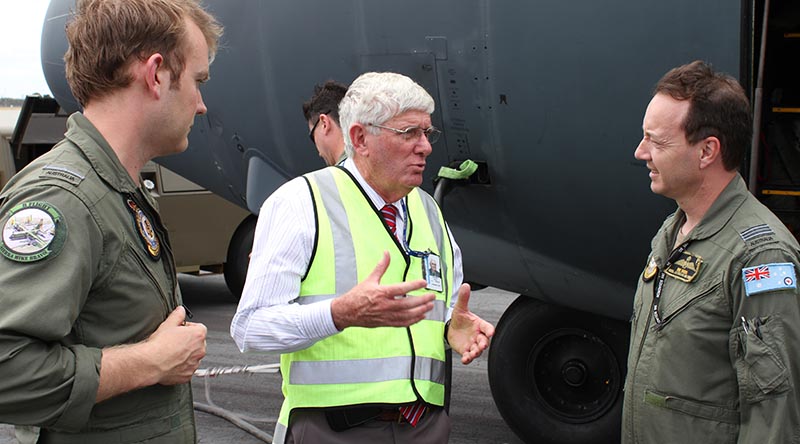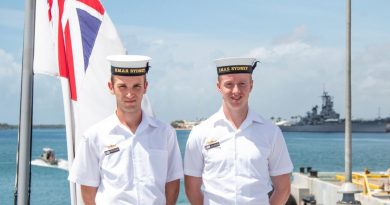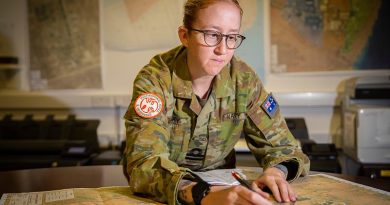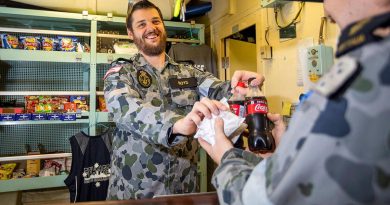Sharing a passion for history and hardware

In 1967, David Gardner was introduced to the latest aviation technology through his work on Air Force’s Mirage, Sabre and Vampire fleet; technology he still works with today.
FILE PHOTO (2012): RAAF Museum Curator Dave Gardner speaks with Flying Officer Brett Aaker (left) and Squadron Leader Robert Sokol, pilots of the final C-130H Hercules flight to the RAAF Museum at Point Cook.
While Air Force now flies F-35As, fifth-generation technology, the aircraft that were leading edge in the post-Korean War period are now museum pieces in the RAAF Museum at Point Cook where Mr Gardner is the Air Force curator.
“When I left the Air Force to work in the RAAF Museum I was working on the F-111 so I’d seen the rise in technology from subsonic to supersonic,” Mr Gardner said.
“Being a technician working on those aircraft was very interesting, rewarding and it took me around the world.
“It was just one of those things I grew up with and I loved it.
“Previously as Museum director and now as the Air Force curator, I have never had any trouble getting out of bed to come to work.”
And millions of Australians who have visited the RAAF Museum at RAAF Base Point Cook, Victoria, have benefitted from decades of commitment by Mr Gardner and his team, with professional displays of the RAAF’s history from its creation to today.
“Dad was in the Air Force and he served overseas in World War II,” Mr Gardner said.
When my brother, an Air Force cook, told me how wonderful the Air Force was, I decided to join.
“I just enjoyed Air Force life and going to work every day was simply great.
“Now as Air Force curator I find there is always something to do, something to fix, something to refine.
“I had worked on most of the aircraft in the museum when they were operational and I’ve worked on them since, looking after them in the museum and I’m quite proud of that fact.
“At the museum you have to stop and think ‘I’m not in the RAAF, I’m talking to someone who doesn’t know anything about the RAAF’; you’ve got to get the message across to people who walk in here to visit the museum so that they walk out of here knowing what the RAAF is all about.
“To do that, you’ve got to do it through the displays. Air Force will be 100 years old this year and the history is great.
“We’ve got to be proud of our history. You learn from history, if you don’t, you’ll fail.
“The displays have to be personal. You’ve got to get across that we’re not just a machine, we’re real people doing a real job and we like it.”
And Mr Gardner will leave behind a comprehensive story about real people, depicted in displays, of 100 years of Air Force service to the people of Australia.
A story, which, thanks to Mr Gardner and his team, will continue to be told at the RAAF Museum about an Air Force with an exemplary history of service, from aircraft of wood and paper to aircraft of supersonic capabilities.
Air Force will mark its centenary on March 31. For details, visit www.airforce.gov.au/100.
.
.

.
.






A great article about Dave Gardner. Dave and I served together at No 2 Squadron on the magnificent Canberras. I was doing the bulk of the post maintenance test flying so got to know and rely heavily on Dave as the then senior airframe specialist. Following the disbandment of the squadron Dave and I served together at Point Cook at the time when he was appointed as the RAAF Museum Curator. I was part of the three person interview panel that selected him for the position and Dave, to this day, blames me for his involvement with the museum. When Dave took up his role as Curator the museum comprised a collection of static, dusty aircraft jammed into some derelict hangars and an assortment of memorabilia spread through old building around the base. What Dave Gardner has overseen over the past 35 years is an incredible transformation with the RAAF Museum now ranking as one of the finest military museums anywhere. Dave has always led from the front with an unbridled enthusiasm that has resulted in this incredible transformation. Well done DG the Air Force and indeed all of us owe you a great debt of gratitude. What you have achieved is nothing short of spectacular.
I liked the article on David Gardiner – Curator of the RAAF Museum. As he said, he joined the RAAF in 1967 and by the time he had completed all his training as an Airframe Fitter, and posted to the unit at Amberley who trained the aircrew on the Canberra bomber aircraft, it was just a bit late for Dave to be posted to No 2 Squadron in Vietnam. That was a shame as Dave was an outstanding Airframe Fitter and knew the Canberra like the back of his hand.
When 2 Squadron returned to Australia and began flying again from Amberley, Dave found himself working on his beloved Canberra – again. Dave was fortunate enough to stay in 2 Squadron right until the squadron was disbanded in 1982.
I’m not sure if Dave would remember me, as I last saw him in October 1982 when 2 Squadron folded.
I first met Dave in 1981 when I was posted back to the Canberra aircraft after some 16 years working on other types). At this point, he was probably the most knowledgeable person on Canberra aircraft in the RAAF. I was one of 6 SNCOs (including Dave) who stayed with the squadron from its formal date of ceased flying at 30 June 1982, until we finally closed the doors in 31 October 1982. Shortly after that, Dave was posted to the RAAF Museum at Point Cook (now known as RAAF Williams).
BTW: The disbandment of 2 Squadron in 1982 was the ONLY time since the end of World War II that a squadron was disbanded at the same time that the aircraft type also disbanded, as that was the last squadron to fly the Canberra, (known as the Grand Old Lady of the skies). There were several occasions over the years when an aircraft type was disbanded, but the squadron would be refitted with a new type, OR, a squadron may have been disbanded but the aircraft type flew on with other squadrons.
Sadly, the demise of 2 Squadron was spoilt by some very bad administration from Dept of Air in Canberra.
In July 2000, I attended a colour parade at Williamtown when the 2 Squadron colours were drawn out of storage and presented once again as the squadron was to be reformed. At that time, the squadron had about 45 personnel and no aircraft, but they were coming. In recent times, it is pleasing to see the squadron achieving great things as an EWAC over in the Middle East.
Yes, Dave is a most knowledgeable fellow and I think he is in the right spot.
Well done Dave.
John Clarkson
via email